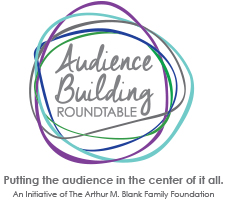By Ellen Walker from the Pacific Northwest Ballet
This post is excerpted from the plenary session of The Arthur M. Blank Family Foundation’s November 2, 2015 workshop, Art of Change: Building Your Organization for Audiences. This is from an exchange among Dr. Bob Harlow, the moderator and lead researcher for the Wallace Foundation’s audience building initiative and three panelists, all of whom were participants in the Wallace initiative: Ellen Walker, Executive Director of the Pacific Northwest Ballet; Magda Martinez, Director of Programs for the Fleisher Art Memorial; and Christopher Taylor, President of The Clay Studio.
Dr. Harlow: Did you have to change who you are (as an organization) to increase your audience? How much did you have to change?
“We thought we were elevating the art form, to show it in its ultimate perfection and in fact we were creating distance.”
Walker: We had to change a lot. We were lacking visual context, our website was old and clunky, we had created distance with young people, and I think with a lot of people, actually, without knowing it. We thought we were elevating the art form, to show it in its ultimate perfection and in fact we were creating distance. We were not creating a relationship. We were elevating the art form and not speaking to the audience at all. So we changed our website, we changed out collateral, we changed out tone of voice, we dove into social media, we asked for feedback. We had to get very humble very fast.
“So we had to make revisions to everything – from our website to marketing materials – and even to our course catalog."
Martinez: It was really important for us to understand who we were as an institution. Institutions have a personality. You don’t know it because you’re in it. But institutions are made of people, and those people probably have shared values and they have shared experiences that actually bring them to the institution. So we had to make revisions to everything - from our website to marketing materials - and even to our course catalog. We targeted 3 communities — Southeast Asians, Latinos (specifically Mexicans,) and a long-established African-American community. And what they told us was “your course catalog looks like a college catalog.”
Until someone says something like this to you, you don’t really think about the fact that most of your staff is college-educated. So to us this looks familiar. We understand how to use it; we understand how it works. We went from a very large course catalog to one page: one page with a grid on it. All of our students love the new one sheet course catalog. They come in and I see people taking the sheet and they’re circling items in it, and they carry it around now in a way that they didn’t before we made the change. I think it’s really important as an organization to understand that what you learn in one area can carry through to the rest of your work. I believe that it is one of the most important ways to sustain the work.
“We learned that responding to complaints is what helps build your business.”
Taylor: If you're doing it correctly, you will change. We changed our marketing material. We had a course “Shaping the Future of Ceramics” and it became “Come Get Dirty with Us.” Messaging is one thing - but course length and time is another. Imagine someone coming in and saying “oh I took ceramics in high school. Can I take a class?” And we say, “Sure, that’s 10 weeks and $300.” That’s a hell of a step that many folks didn’t make. So we started offering 5-week classes, 1-night classes, weekend classes – all so people could get a dabble. We also realized in our research that 51% of people were hearing about us from word of mouth. Audience building was about customer service and it became about who we were hiring to market us, and about how we were giving people an experience. We learned that responding to complaints is what helps build your business. So… from our revised messaging, to a new way of hiring staff, to the new board members we recruited, to simplified catalog descriptions: be prepared for all of that to change and be willing to put it all on the table with an honest assessment of “my message isn’t working, I’m putting out the wrong face.” It’s an important moment for an organization.
Martinez: The point you're making about staff became very apparent during this process for us. I call this work our great internal cultural shift; it was to realize that your whole staff has a whole network of people. And they are talking to them about work and they are talking to them about this place and how they perceive it. And they also have access to some of the people you are trying to reach. But we tend to look at who is doing the work and we compartmentalize that. It’s important to look at your whole staff as people who are your ambassadors. And people who have networks and outside lives themselves who probably have important information for you.
Click here for the complete report from the Art of Change workshop and Click here for December’s blog post by Sara Leonard, co-author of the 2015 NEA Study: When Going Gets Tough.
Keywords: Pacific Northwest Ballet, Fleischer Art Memorial, The Clay Studio, relationship, Audience Building, Customer Service, Ambassadors
